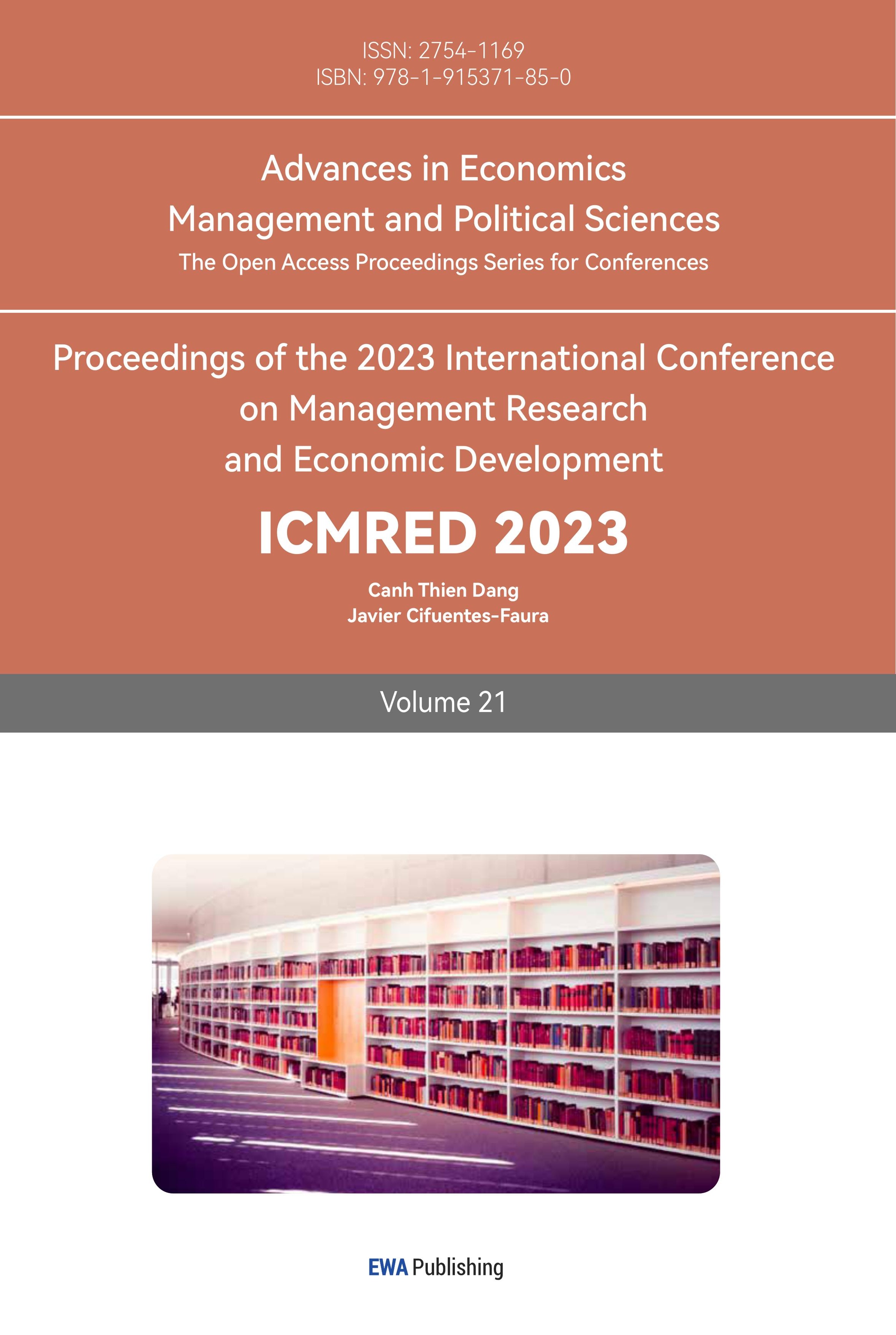References
[1]. 1.Ramirez, Octavio A. “The Asymmetric Cycling of U.S. Soybeans and Brazilian Coffee Prices: An Opportunity for Improved Forecasting and Understanding of Price Behavior.” Journal of Agricultural and Applied Economics, vol. 41, no. 1, Apr. 2009, pp. 253–270.
[2]. Rhiney, Kevon, et al. “Epidemics and the Future of Coffee Production.” Proceedings of the National Academy of Sciences, vol. 118, no. 27, 28 June 2021, p. e2023212118.
[3]. Silveira, Rodrigo Lanna F. da, et al. “The Reaction of Coffee Futures Price Volatility to Crop Reports.” Emerging Markets Finance and Trade, vol. 53, no. 10, 5 Aug. 2016, pp. 2361–2376, https://doi.org/10.1080/1540496x.2016.1205976. Accessed 25 Feb. 2023.
[4]. Mueller, Bernardo.”The political economy of the Brazilian model of agricultural development: Institutions versus sectoral policy.” The Quarterly Review of Economics and Finance, vol 62, Nov. 2016, pp.12-20,https://doi.org/10.1016/j.qref.2016.07.012
[5]. Oliveira, Gislaine, et al. “Influence of Temperature and Water Activity on Ochratoxin a Production by Aspergillus Strain in Coffee South of Minas Gerais/Brazil.” LWT, vol. 102, Mar. 2019, pp. 1–7, https://doi.org/10.1016/j.lwt.2018.12.032. Accessed 25 Feb. 2023.
[6]. Jarvis, Lovell S. “The Rise and Decline of Rent-Seeking Activity in the Brazilian Coffee Sector: Lessons from the Imposition and Removal of Coffee Export Quotas.” World Development, vol. 33, no. 11, Nov. 2005, pp. 1881–1903, https://doi.org/10.1016/j.worlddev.2005.06.003. Accessed 5 Dec. 2019.
[7]. “Obstacles to Consumption: Tariff and Non- Tariff Measures and Their Impact on the Coffee Sector Interim Report Background 1. Wi.” Webcache.googleusercontent.com, 2020, webcache.googleusercontent.com/search?q=cache:iUmajloZd5YJ:www.ico.org/documents/. Accessed 25 Feb. 2023.
[8]. Capps, Oral, et al. “A Cross‐Sectional Analysis of the Demand for Coffee in the United States.” Agribusiness, 18 Nov. 2022, https://doi.org/10.1002/agr.21779. Accessed 25 Feb. 2023.
[9]. Wei, Xiaoyun. “The impact of COVID-19 pandemic on transmission of monetary policy to Finance markets. “ International Review of Financial Analysis , vol.74, Mar. 2021.
Cite this article
He,R.;Liu,Y. (2023). Whether Factors Affecting the Price of US Coffee C Futures Are Influenced by the COVID-19 Social Environment. Advances in Economics, Management and Political Sciences,21,280-289.
Data availability
The datasets used and/or analyzed during the current study will be available from the authors upon reasonable request.
Disclaimer/Publisher's Note
The statements, opinions and data contained in all publications are solely those of the individual author(s) and contributor(s) and not of EWA Publishing and/or the editor(s). EWA Publishing and/or the editor(s) disclaim responsibility for any injury to people or property resulting from any ideas, methods, instructions or products referred to in the content.
About volume
Volume title: Proceedings of the 2023 International Conference on Management Research and Economic Development
© 2024 by the author(s). Licensee EWA Publishing, Oxford, UK. This article is an open access article distributed under the terms and
conditions of the Creative Commons Attribution (CC BY) license. Authors who
publish this series agree to the following terms:
1. Authors retain copyright and grant the series right of first publication with the work simultaneously licensed under a Creative Commons
Attribution License that allows others to share the work with an acknowledgment of the work's authorship and initial publication in this
series.
2. Authors are able to enter into separate, additional contractual arrangements for the non-exclusive distribution of the series's published
version of the work (e.g., post it to an institutional repository or publish it in a book), with an acknowledgment of its initial
publication in this series.
3. Authors are permitted and encouraged to post their work online (e.g., in institutional repositories or on their website) prior to and
during the submission process, as it can lead to productive exchanges, as well as earlier and greater citation of published work (See
Open access policy for details).
References
[1]. 1.Ramirez, Octavio A. “The Asymmetric Cycling of U.S. Soybeans and Brazilian Coffee Prices: An Opportunity for Improved Forecasting and Understanding of Price Behavior.” Journal of Agricultural and Applied Economics, vol. 41, no. 1, Apr. 2009, pp. 253–270.
[2]. Rhiney, Kevon, et al. “Epidemics and the Future of Coffee Production.” Proceedings of the National Academy of Sciences, vol. 118, no. 27, 28 June 2021, p. e2023212118.
[3]. Silveira, Rodrigo Lanna F. da, et al. “The Reaction of Coffee Futures Price Volatility to Crop Reports.” Emerging Markets Finance and Trade, vol. 53, no. 10, 5 Aug. 2016, pp. 2361–2376, https://doi.org/10.1080/1540496x.2016.1205976. Accessed 25 Feb. 2023.
[4]. Mueller, Bernardo.”The political economy of the Brazilian model of agricultural development: Institutions versus sectoral policy.” The Quarterly Review of Economics and Finance, vol 62, Nov. 2016, pp.12-20,https://doi.org/10.1016/j.qref.2016.07.012
[5]. Oliveira, Gislaine, et al. “Influence of Temperature and Water Activity on Ochratoxin a Production by Aspergillus Strain in Coffee South of Minas Gerais/Brazil.” LWT, vol. 102, Mar. 2019, pp. 1–7, https://doi.org/10.1016/j.lwt.2018.12.032. Accessed 25 Feb. 2023.
[6]. Jarvis, Lovell S. “The Rise and Decline of Rent-Seeking Activity in the Brazilian Coffee Sector: Lessons from the Imposition and Removal of Coffee Export Quotas.” World Development, vol. 33, no. 11, Nov. 2005, pp. 1881–1903, https://doi.org/10.1016/j.worlddev.2005.06.003. Accessed 5 Dec. 2019.
[7]. “Obstacles to Consumption: Tariff and Non- Tariff Measures and Their Impact on the Coffee Sector Interim Report Background 1. Wi.” Webcache.googleusercontent.com, 2020, webcache.googleusercontent.com/search?q=cache:iUmajloZd5YJ:www.ico.org/documents/. Accessed 25 Feb. 2023.
[8]. Capps, Oral, et al. “A Cross‐Sectional Analysis of the Demand for Coffee in the United States.” Agribusiness, 18 Nov. 2022, https://doi.org/10.1002/agr.21779. Accessed 25 Feb. 2023.
[9]. Wei, Xiaoyun. “The impact of COVID-19 pandemic on transmission of monetary policy to Finance markets. “ International Review of Financial Analysis , vol.74, Mar. 2021.









